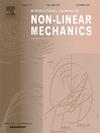热塑性聚合物的超非弹性有限变形建模。第一部分:不同结晶度和变形速率下的半结晶聚合物
IF 2.8
3区 工程技术
Q2 MECHANICS
International Journal of Non-Linear Mechanics
Pub Date : 2025-03-25
DOI:10.1016/j.ijnonlinmec.2025.105091
引用次数: 0
摘要
本系列论文由两部分组成,旨在介绍一种新的建模方法(即超弹性)在热塑性聚合物的大弹性和非弹性变形行为中的应用。在第一篇论文(即第一部分)中,我们将以聚乙烯(PE)试样为研究对象,对半结晶聚合物的大变形进行建模。我们将模拟聚乙烯试样在不同结晶度比和不同变形率下的单轴拉伸变形行为。将利用核心变形能量函数 W 作为 Cauchy-Green 变形张量的第一 I1 和第二 I2 主不变式的函数。然后将对这一核心函数进行扩展,以纳入结晶度比和变形速率等额外的非弹性诱导因素。我们将为这一纳入提供总体理论框架,并定义和设计这些非弹性诱导因素的具体适当测量方法,将其纳入核心模型。随后将增强模型与实验数据进行拟合,显示出良好的亲和力和建模结果。利用校准模型,还将对试样在其他比率/速率下的大变形进行预测,并与实验数据进行验证。该模型简单易用,可纳入额外的非弹性效应,并能对试样的弹性和非弹性行为进行精确模拟和预测,这些特点决定了它在应用于半结晶聚合物有限应变方面的多功能性和实用性。第二部分将研究和介绍同一建模方法在无定形聚合物的弹性和非弹性行为中的专门应用。本文章由计算机程序翻译,如有差异,请以英文原文为准。
Modelling the finite deformation of thermoplastic polymers via hyperinelasticity. Part I: A semi-crystalline polymer under varying crystallinity ratios and deformation rates
The aim of this two-part paper series is to present the application of a new modelling approach, namely hyperinelasticity, to the large elastic and inelastic deformation behaviours of thermoplastic polymers. In this first contribution, namely Part I, we are concerned with modelling the large deformation of semi-crystalline polymers, by way of considering Polyethylene (PE) specimens. The deformation behaviour of PE samples under uniaxial tensile deformation with various crystallinity ratios and under different deformation rates is modelled. A core deformation energy function will be utilised, as a function of the first and second principal invariants of the Cauchy–Green deformation tensor(s). This core function will then be augmented to incorporate the additional inelasticity-inducing factors of crystallinity ratio and the rate of deformation. The general theoretical framework for this incorporation is underpinned, and specific appropriate measures of those inelasticity-inducing factors will be defined and devised, incorporated into the core model. The ensuing augmented model is then fitted with the experimental data, showing favourable affinity and modelling results. Using the calibrated model, predictions of the large deformations of the specimens at other ratios/rates will also be made, and verified against the experimental data. The simplicity of the model, its amenability for incorporating additional inelastic effects, and its ability in providing both accurate simulations and predictions of the elastic and inelastic behaviours of the samples concludes its versatility and usefulness for application to the finite strains of semi-crystalline polymers. Part II will investigate and present the specialised application of the same modelling approach to the elastic and inelastic behaviours of amorphous polymers.
求助全文
通过发布文献求助,成功后即可免费获取论文全文。
去求助
来源期刊
CiteScore
5.50
自引率
9.40%
发文量
192
审稿时长
67 days
期刊介绍:
The International Journal of Non-Linear Mechanics provides a specific medium for dissemination of high-quality research results in the various areas of theoretical, applied, and experimental mechanics of solids, fluids, structures, and systems where the phenomena are inherently non-linear.
The journal brings together original results in non-linear problems in elasticity, plasticity, dynamics, vibrations, wave-propagation, rheology, fluid-structure interaction systems, stability, biomechanics, micro- and nano-structures, materials, metamaterials, and in other diverse areas.
Papers may be analytical, computational or experimental in nature. Treatments of non-linear differential equations wherein solutions and properties of solutions are emphasized but physical aspects are not adequately relevant, will not be considered for possible publication. Both deterministic and stochastic approaches are fostered. Contributions pertaining to both established and emerging fields are encouraged.

 求助内容:
求助内容: 应助结果提醒方式:
应助结果提醒方式:


